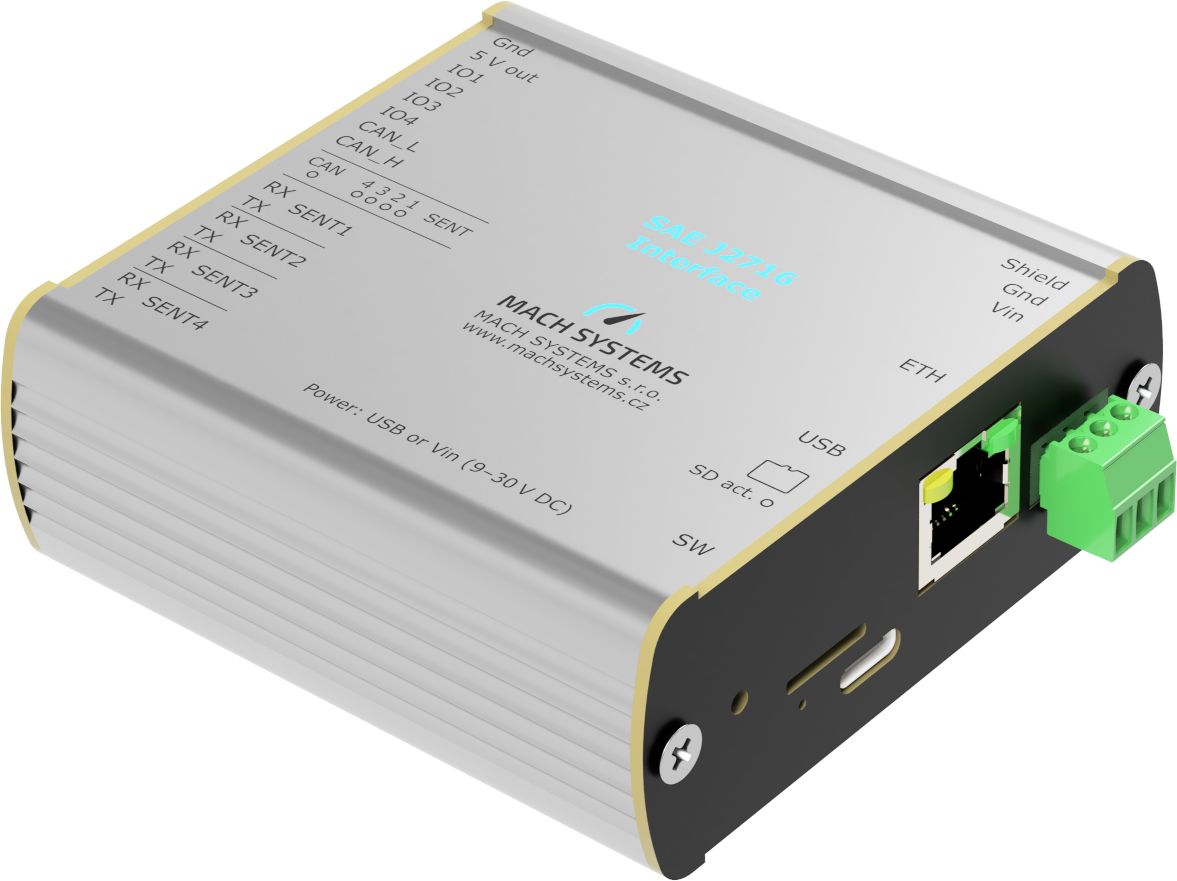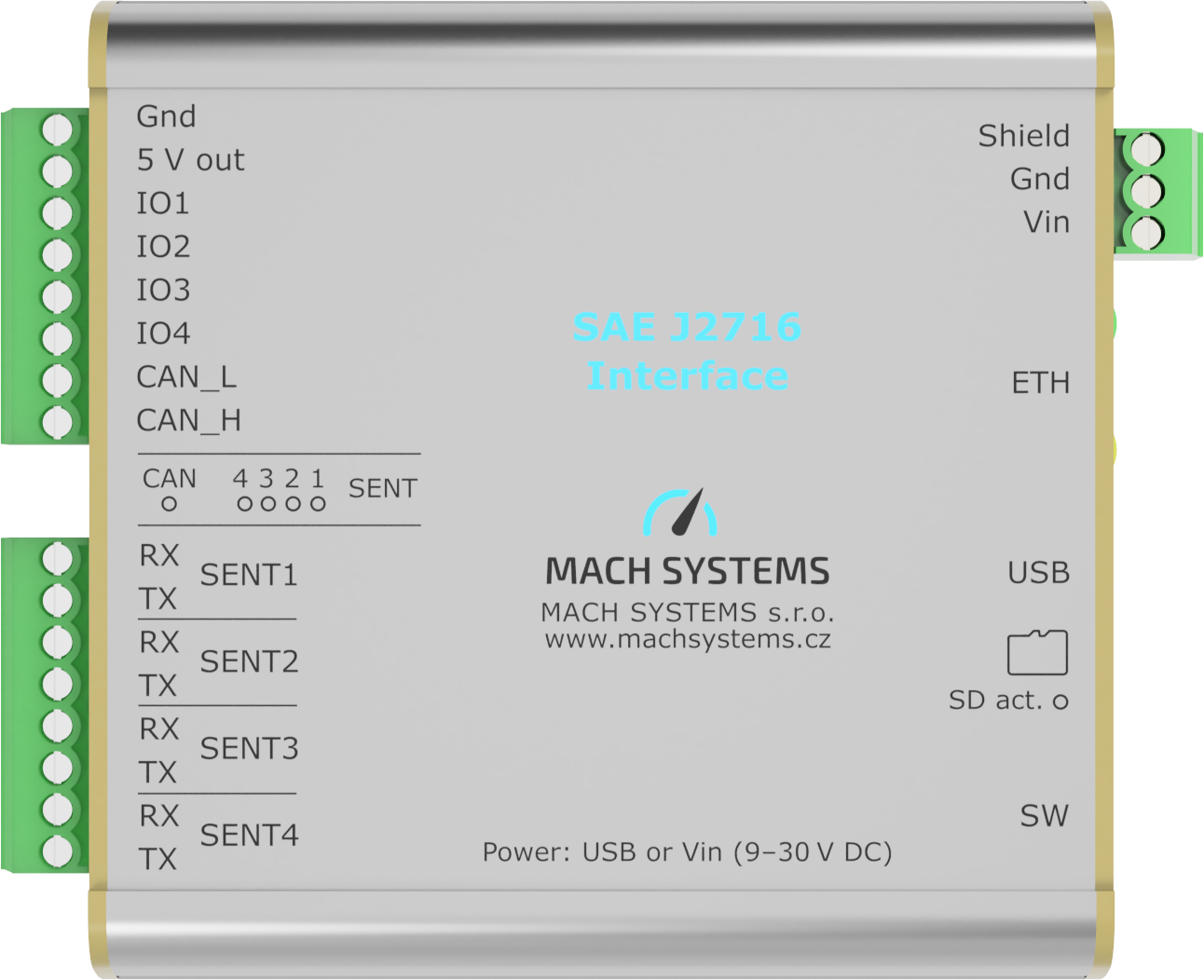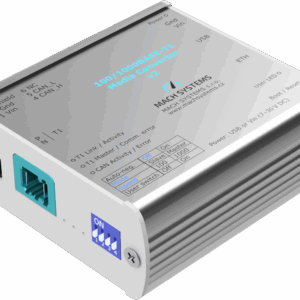Description
The SAE J2716 Interface features four SENT channels, an Ethernet port, a USB port, a CAN(/FD) channel, four analogue channels and a MicroSD card slot. The device can be used as a SENT to Ethernet/USB/CAN(/FD) gateway, a SENT-analogue converter, a stand-alone SENT and CAN(/FD) data logger, or as an Ethernet-CAN(/FD) or a USB-CAN(/FD) interface.
SAE J2716 Interface – Data Sheet
SAE J2716 Interface – User Manual
Specification:
- 4 bi-directional SENT channels
- Fast, Short serial and Enhanced serial message format support
- Short PWM Code (SPC) support
- Ethernet (10/100)
- CAN(/FD)
- USB 2.0
- 4 analogue inputs/outputs mappable onto SENT data
- MicroSD card slot for stand alone data logging and playback
- RTC with battery backup
- Web interface for easy configuration
- Free-of-charge PC application for configuration, reception, transmission and logging
- Communication protocol over Ethernet, USB and CAN(/FD) for integration
- Can be used as a USB-CAN(/FD) or Ethernet-CAN(/FD) interface
- USB or externally powered
- Aluminium enclosure
- DIN rail mounting possibility
Use-cases:
- Bi-directional SENT interface
- SENT – Ethernet
- SENT – CAN(/FD)
- SENT – USB
- SENT to analogue outputs
- Analogue inputs to SENT
- Stand-alone SENT and CAN(/FD) data logger
- Ethernet/USB to CAN(/FD) interface
The SAE J2716 Interface can be used as a bi-directional gateway between SENT and Ethernet/USB/CAN(/FD), or as a stand-alone data logger of SENT and CAN(/FD) communication on a MicroSD card. The four analogue channels can be mapped on both received and transmitted SENT data, enabling a SENT-to-analogue output or analogue input-to-SENT conversion. The device can also act as a USB-CAN(/FD) or Ethernet-CAN(/FD) interface simultaneously to its SENT gateway/converter function.
The SAE J2716 Interface offers four bi-directional SENT channels and supports reception and transmission of Fast and Slow (both Short serial and Enhanced serial) message formats. Each SENT channel can be configured independently (direction, tick time, nibble count, pause pulse), and an intelligent filtration of incoming SENT frames can be used so that USB / CAN(/FD) / ETH communication does not get overloaded.
The interface offers advanced SENT features such as SPC (Short PWM Code) mode, CRC fault injection (both Fast and Slow messages), and supports up to 8 data nibbles. CAN identifiers for both TX and RX are configurable which allows multiple SAE J2716 Interfaces to be used simultaneously on the same CAN bus.
Interface and Gateway
The four SAE J2716 (SENT) channels can be accessed over Ethernet / USB / CAN(/FD). The user can receive and transmit both Fast and Slow SENT messages. The device can be configured to automatically forward incoming SENT frames onto the CAN(/FD) bus.
Stand Alone Data Logger
The stand-alone data logging function allows to log both SENT and CAN(/FD) frames including an RTC timestamp on a MicroSD card. The captured data can later be converted and analysed on PC, or played back onto SENT channel(s) in real time.
SENT to Analogue Conversion
The interface offers four analogue channels, each one configurable as input or output that can be mapped onto any of the device’s SENT channels. The conversion settings are configurable by the user – start bit, bit length, linear transfer function: multiplier, offset, min/max voltage limits. The analogue input range is 0-5 V, and the analogue output range is 0 – 4.095 V (12-bit DAC).
Software
The device can be easily configured over its web server or with the help of the free-of-charge SAE J2716 Interface Tool PC application (Windows 64-bit, .NET Framework 4.8) that also offers more advanced data monitoring, logging, and simulation.
Integration and .NET API
The open communication protocol over Ethernet, USB, or CAN(/FD) allows easy integration of the interface into a third-party system, such as end-of-line testers, test benches, and HiL testers.
A .NET SDK (p/n: MACH-SENT-ETH-NET-SDK), supplied as a .NET DLL, enables to access the device over Ethernet, USB (VCP), or CAN/FD. The API provides an easy way to control the SAE J2716 Interface from a Microsoft .NET application.
Both the protocol and SDK allows to:
- Configure the device (Ethernet, CAN(/FD))
- Configure the SENT channels
- Receive and transmit SENT Fast and Slow messages
- Configure the analogue I/Os and their mapping
- Configure MicroSD card logging and playback
- Use the device as an Ethernet-CAN(/FD) or USB-CAN(/FD) interface













